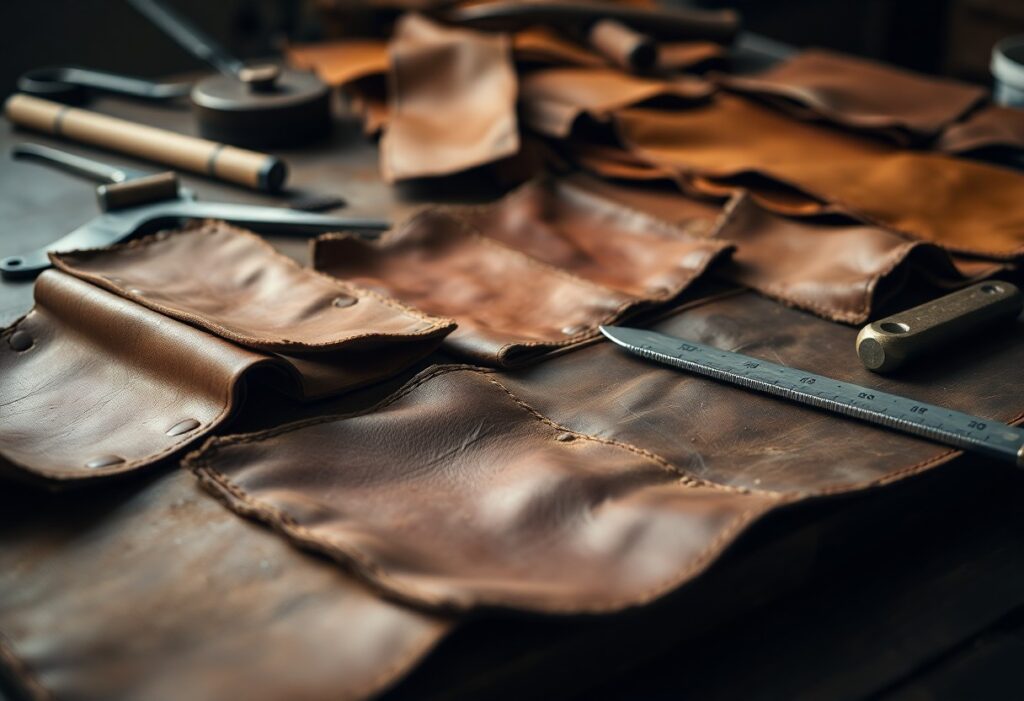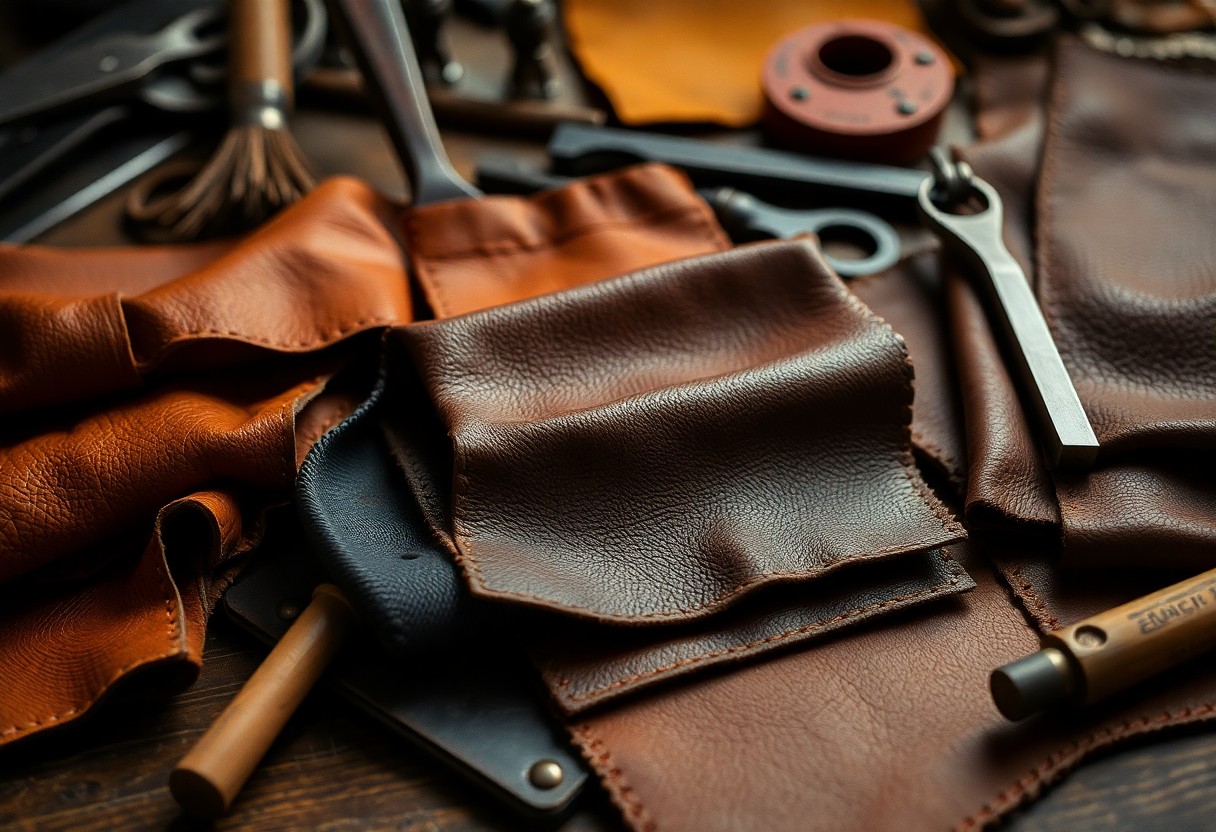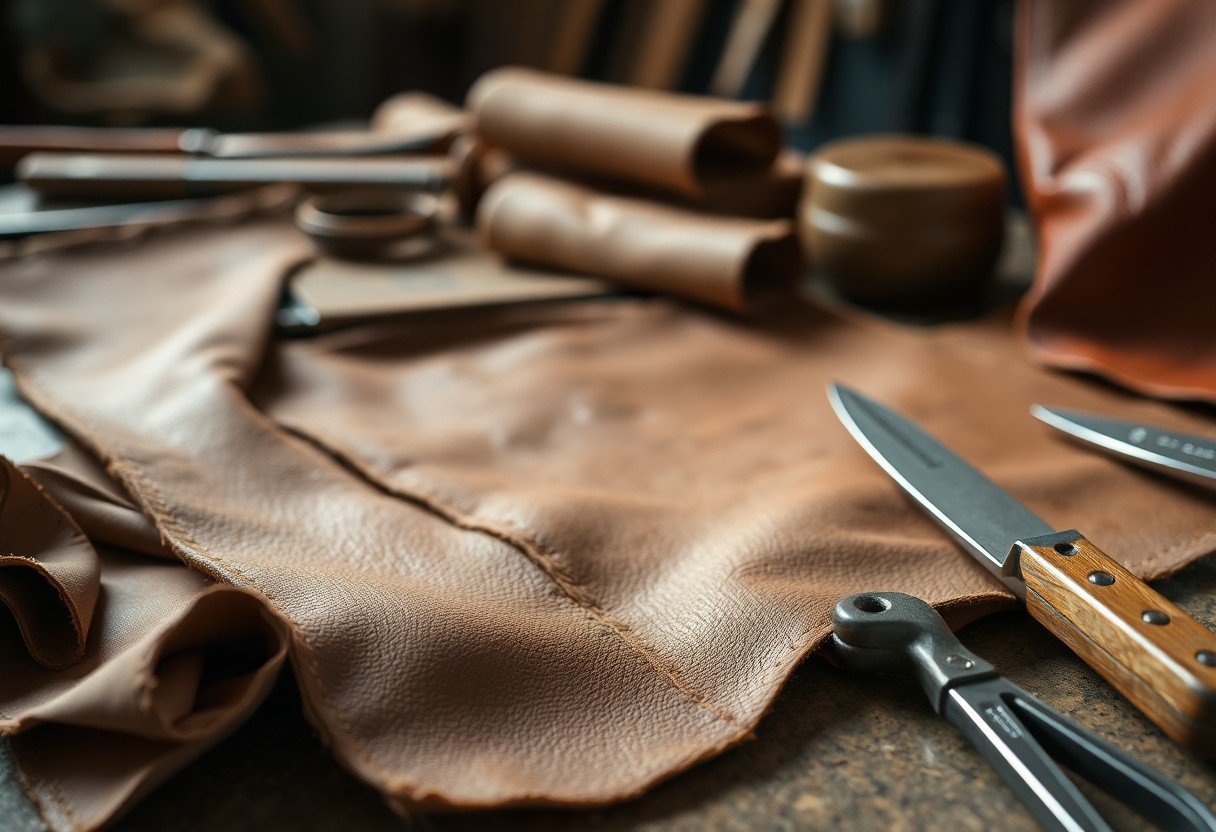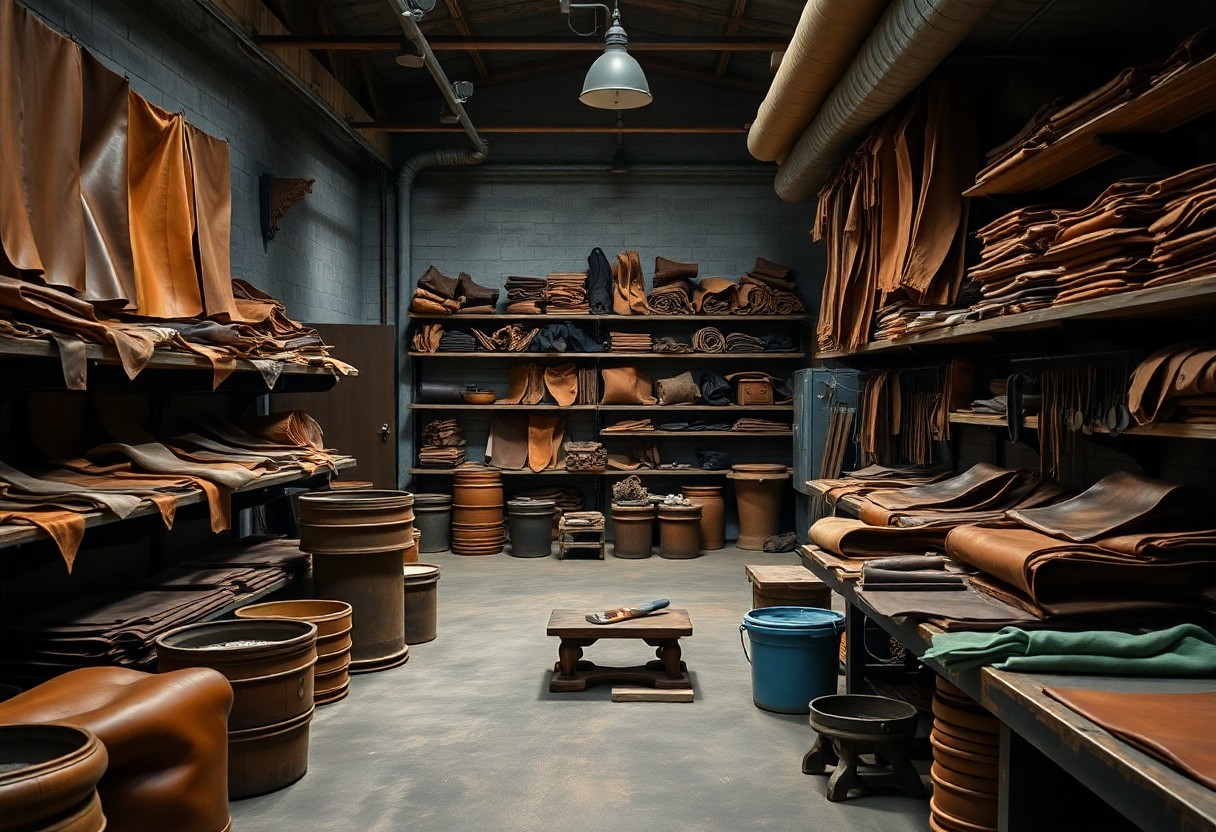
The journey of leather tanning has transformed over the years into a sophisticated process that greatly influences the final quality of leather products you encounter. Various tanning methods produce distinct characteristics in leather, affecting crucial attributes like durability, water resistance, texture, and color retention. This intricate process begins with raw hides and moves through key stages such as chrome tanning, vegetable tanning, or chrome-free methods. Each technique uniquely affects the leather’s properties, which ultimately influences its functionality and maintenance requirements. By comprehensively understanding these processes, you can make informed decisions about leather quality, factoring in environmental considerations, since some methods are significantly more eco-friendly than others.
Discover the Diverse Leather Tanning Methods and Their Uses
Producing leather involves an array of tanning methods that convert raw hides into functional, attractive leather goods. The primary techniques utilized include chrome tanning, vegetable tanning, and chrome-free tanning. This detailed guide aims to provide you with a clear understanding of the nuances associated with each method, empowering you to select the one that perfectly aligns with your leather requirements.
| Method | Characteristics |
| Chrome Tanning | Fast, water-resistant, 85% of global production |
| Vegetable Tanning | Natural, eco-friendly, 10% of production |
| Chrome-free Tanning | Environmental-friendly, 5% of production |
| Combination Tanning | Blends multiple methods for unique properties |
| Aldehyde Tanning | Specialized process for specific applications |
Gain Insights into the Chrome Tanning Process and Its Benefits
The chrome tanning method utilizes chromium (III) salts to create leather that is not only soft and flexible but also highly sought after across various applications. This process yields leather that boasts water resistance and readily absorbs dyes, making it a favored choice in the leather industry. The remarkable efficiency of chrome tanning allows for completion in a mere 24-48 hours, which is crucial for meeting mass production demands.
Discover the Timeless Craft of Vegetable Tanning
As one of the oldest and most revered methods, vegetable tanning employs natural tannins derived from tree bark and leaves. This traditional approach is celebrated for its ability to produce leather that develops a rich patina over time, thereby aging beautifully while remaining biodegradable. Different types of vegetable tanning, including those utilizing oak bark, chestnut, and mimosa extracts, contribute to the distinctive characteristics of the final leather product. This meticulous process typically spans approximately 4-6 weeks, resulting in leather that is generally firmer and more structured compared to its chrome-tanned counterparts.

Step-by-Step Overview of the Leather Tanning Process
Transforming raw hides into high-quality, finished leather involves a systematic and well-defined process. Here’s an in-depth exploration of each crucial step and its significance in achieving the desired leather quality.
Vital Pre-tanning Procedures for Ensuring Leather Quality
To achieve the highest quality leather, raw hides are subjected to a series of careful preparation measures. This initial stage includes soaking the hides in clean water for 24-48 hours to remove salt and dirt, followed by a liming process that effectively eliminates hair and fats. It is crucial to maintain precise pH control during this stage to safeguard the integrity of the hides and prevent any damage.
Essential Steps in the Primary Tanning Process
The pretanning phase encompasses deliming and pickling to prepare the hides for the primary tanning agents. The most common technique employed is chrome tanning, which utilizes chromium sulfate and can produce leather within an impressive timeframe of just 24 hours. In contrast, the vegetable tanning process harnesses natural tannins and can take approximately 20-60 days to complete.
An additional critical aspect of the tanning process is temperature control. Chrome tanning typically occurs at temperatures ranging from 35-40°C, while vegetable tanning is conducted at lower temperatures of 20-25°C. Constant monitoring of pH levels is essential to avoid damaging the leather and to ensure optimal absorption of tanning agents.
Techniques for Effective Leather Treatment to Enhance Quality
A variety of techniques exist to enhance the attributes of your leather. Ranging from surface finishing to deep penetration treatments, each method serves a distinct purpose. With the appropriate treatment, you can extend your leather’s lifespan by up to 50% while significantly improving its resistance to water, heat, and wear.
Understanding Different Surface Treatments for Leather
Surface treatments applied to leather can include waxing, buffing, and protective coatings. These methods can enhance water resistance by up to 70% and allow for customization between a shiny or matte finish according to your personal preference. Additionally, surface treatments play a vital role in safeguarding leather against UV damage and everyday wear and tear, ensuring longevity and aesthetic appeal.
Dyeing Techniques Impacting Color and Longevity of Leather
Your leather can absorb various types of dyes at different depths. For instance, aniline dyeing deeply penetrates the leather, while surface dyeing provides more controlled color application. The dyeing technique you select will directly impact both the aesthetic and durability aspects of the leather.
Furthermore, the dyeing method you choose significantly affects the final characteristics of the leather. Drum dyeing can achieve up to 95% color penetration, while spray dyeing offers enhanced precision in color control. It is pertinent to note that natural dyes are eco-friendlier but may fade approximately 20% faster compared to their chemical counterparts, making the choice of dye critical for both appearance and environmental considerations.

Key Factors Influencing Leather Quality Throughout Processing
The quality of leather is shaped by numerous interconnected variables throughout the processing chain. Understanding these factors is crucial for achieving excellent outcomes in both leather selection and care. The tanning method, hide quality, and processing parameters all significantly influence the final properties of the leather. By mastering these elements, you will be better prepared to assess leather quality in relation to your specific needs.
Choosing Raw Materials for Superior Leather Quality
When selecting raw materials, it’s essential to prioritize the condition of the hides and the source of the animals. The quality of your raw materials directly impacts the final leather’s properties. The best hides typically come from healthy animals and showcase minimal surface imperfections. Look for thickness consistency and the absence of parasitic damage. Selecting materials based on their intended use is also vital, as different applications demand specific hide characteristics to ensure optimal performance.
The Significance of Processing Parameters in Ensuring Quality
A direct correlation exists between processing controls and overall leather quality. Maintaining strict oversight of pH levels, temperature, and chemical concentrations is paramount. The tanning duration typically ranges from 24 to 48 hours, with temperature controls held between 35-40°C. Diligent attention to these parameters guarantees consistent leather quality throughout the production process.
This meticulous approach should apply to each stage of processing. It is crucial to monitor moisture content (ideally 45-55%), sustain appropriate drum speed during tanning, and ensure accurate chemical dosing. Furthermore, managing drying conditions is essential to avoid damaging the leather. A thorough focus on these factors culminates in the production of higher-quality finished leather.
Expert Strategies for Achieving Exceptional Leather Treatment Results
Not all leather treatment processes yield the same level of quality. It’s crucial to focus on temperature control, chemical balance, and timing precision throughout the tanning process to ensure positive outcomes.
- Regularly monitor pH levels
- Maintain consistent temperature
- Adhere to exact chemical ratios
- Document each step meticulously
Being aware of the indicators of proper tanning can empower you to achieve high-quality finished leather that meets your expectations.
Optimizing the Leather Treatment Process for Best Results
To attain optimal results, managing your tanning environment is essential. Keep your workspace at temperatures between 20-25°C and maintain humidity levels around 45-55%. Ensure that your chemical solutions are fresh and precisely measured. Consistent maintenance of your equipment is critical for achieving reliable results and maintaining high-quality standards.
Ensuring Quality Standards in Leather Care and Maintenance
The integrity of leather is heavily dependent on your storage conditions and handling practices. Store your leather in a dry, cool area away from direct sunlight to preserve its quality and prevent deterioration. Regularly check the moisture content and rotate your stock every 30 days to ensure freshness.
Monitoring the entire process is vital for upholding quality standards. Routine checks should encompass pH testing, physical inspections, and moisture content analysis. Document all findings and make adjustments to your procedures based on the outcomes. Consistent quality control is key to detecting potential issues before they negatively impact your final product.

Analyzing the Advantages and Disadvantages of Different Tanning Methods
Gaining a comprehensive understanding of leather tanning necessitates evaluating the various methods based on their respective pros and cons. Below is a thorough comparison of the primary tanning techniques:
| Pros | Cons |
|---|---|
| Chrome tanning: Fast processing, cost-effective | Chrome tanning: Environmental concerns, potential disposal issues |
| Vegetable tanning: Eco-friendly, natural process | Vegetable tanning: Time-consuming, requires higher water usage |
| Chrome-free tanning: Environmental safety, good quality | Chrome-free tanning: Complex process, higher costs |
| Combination tanning: Versatile properties | Combination tanning: Challenging quality control |
Economic Considerations in Leather Tanning Decisions
Choosing leather tanning methods can greatly influence your production expenses. Chrome tanning boasts 85% cost efficiency compared to vegetable tanning, while chrome-free methods tend to increase costs by 20-30%.
The Effect of Tanning Methods on Leather Quality Attributes
The quality of even the finest leather can be severely compromised by poor tanning choices. Your selected tanning method directly impacts attributes such as durability, water resistance, and texture.
For example, leather treated with chrome tanning demonstrates superior water resistance and flexibility, whereas leather subjected to vegetable tanning tends to exhibit better aging characteristics and develops a unique patina over time, enhancing its charm and appeal.
Key Takeaways on Leather Tanning and Treatment Techniques
From the insights shared, it’s clear that various leather tanning and treatment methods have a profound effect on the quality and characteristics of your leather products. The decision between chrome, chrome-free, or vegetable tanning will play a significant role in determining your leather’s durability, texture, and ecological impact. Additionally, the dyeing method you choose—whether it’s aniline or crust—will influence your leather’s color depth and aging properties. Finally, the type of finishing applied—be it full grain, corrected grain, or top-coated—sets the standard for appearance, breathability, and maintenance requirements. A comprehensive understanding of these processes equips you to make informed choices regarding leather purchases and care practices.
Your Questions Answered: Leather Tanning Frequently Asked Questions
Q: What are the main differences between chrome tanning and vegetable tanning?
A: Chrome tanning uses chromium salts to yield soft, water-resistant leather that is processed rapidly and economically, accounting for 85% of global leather production. In contrast, vegetable tanning relies on natural tannins from tree bark and leaves, requiring a longer duration while creating leather that develops character with age. Although vegetable-tanned leather is more environmentally friendly regarding disposal, it is more susceptible to staining than chrome-tanned versions.
Q: How does aniline dyeing affect leather quality and appearance?
A: Aniline dyeing involves immersing leather in dye baths that deeply penetrate the material. This method results in uniform color throughout the leather, offering excellent color retention. Modern aniline-dyed leather is often partially dyed rather than completely, preserving a lighter middle layer. This technique enhances the leather’s stability while providing a pleasing color depth on the surface.
Q: What differentiates full grain leather from corrected grain leather?
A: Full grain leather retains its natural surface without sanding or artificial overlays, showcasing natural pores, the strongest fiber structure, and the ability to be restored when scuffed. In contrast, corrected grain leather undergoes sanding and is coated with a plastic layer. While corrected grain is easier to clean and maintain, it usually lacks breathability and may crack over time with no possibility of repair.
The Article Guide to leather tanning and treatment methods processes types and their impact on quality appeared first on My Shoes Finder
The Article Leather Tanning: Methods, Processes, and Quality Impact Guide Was Found On https://limitsofstrategy.com


It’s fascinating to dive into the world of leather tanning and really appreciate the intricacies behind it. I’ve always been curious how something as commonplace as leather can have such a complex backstory. When I first started exploring leather goods, I was drawn to the durability and unique textures, but I never really considered how these attributes were linked to the tanning process. It’s almost like a hidden art form that shapes not just the leather itself but the entire product life cycle.
What a fascinating exploration of leather tanning! It’s intriguing to think about how much artistry and science goes into this age-old craft. I’ve always been struck by the stark difference in characteristics between leathers produced through various tanning methods. For instance, I have a favorite leather bag that’s chrome-tanned; it’s incredibly supple and water-resistant, but I sometimes wonder how it compares to a more traditionally vegetable-tanned piece.